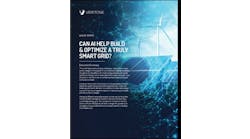ABB‘s President and CEO Ulrich Spiesshofer describes the significance of Solar Impulse, a plane that is essentially a flying microgrid, completing its round-the-world journey using no fossil fuels. The solar-powered plane finished the trip July 23 in Abu Dhabi.
Solar Impulse has made history by completing the first flight around the world in a plane powered only by energy from the sun. Its achievement is a tremendous success for clean technologies and a triumph of technology innovation to change the world.
When Solar Impulse founder Bertrand Piccard first had the idea of flying a solar-powered plane around the world, most people said it would be impossible. There was no way, they said, that an aircraft could get off the ground on solar power alone, much less remain in flight after the sun had gone down. But Piccard and his co-founder André Borschberg refused to give up, and in the course of putting their mission together, they found partners who believed that, with a pioneering spirit and by pushing the boundaries of technology, Solar Impulse could achieve the impossible.
Not surprisingly, those who believed that a solar plane could circumnavigate the globe tended to be innovators themselves. In the case of ABB, we have been technology pioneers for 125 years, since two enterprising entrepreneurs founded a start-up in Switzerland to explore the potential of a promising new technology called electricity. As a global leader in power and automation today, we were eager to see whether our technologies and know-how were up to the challenge of keeping a pilot and plane in the air, day and night, with only the power of sunlight. So we joined Solar Impulse in an innovation and technology alliance and got to work.
For ABB, many of the challenges were familiar, such as maximizing the power yield from the 17,000 solar cells that cover the plane’s wings and fuselage. There was also the pressing need to use energy as efficiently as possible, and to store that energy after the sun had gone down to keep the plane aloft throughout the night.
In preparing for the round-the-world flight and during the mission itself, ABB broke new ground in numerous areas related to clean technologies. One is microgrids, self-sustaining electricity grids powered by solar or wind with battery back-up, which can switch between different energy sources in seconds. Solar Impulse itself is a flying microgrid. In the coming years, microgrids will transform the lives of millions of people by providing electricity access to off-grid communities and enabling industry in places without reliable power supplies.
…microgrids will transform the lives of millions of people
Another innovation developed by ABB while Solar Impulse was gearing up is a groundbreaking new flash-charging technology, which charges an electric bus in 15-seconds while passengers are leaving and boarding the vehicle. Known as TOSA, it requires no overhead wires and is the first sustainable mass transport solution that offers a viable alternative to diesel buses. It is about to go into service in Geneva.
Solar Impulse is as much as forerunner of the digital future as an ambassador for clean technologies. The flight mission control team relied on GPS tracking and satellite connectivity for its communications, while the plane itself is covered in sensors, providing a steady stream of data on all critical parameters, including the condition of all onboard systems as well as, most important of all, the health of the pilot.
On the ground, similar technologies are enabling the emerging “Internet of Things, Services and People” and leading to the transformation of industry. Working with Swatch, ABB has developed the first smart sensor solution for electric motors, enabling improvements in energy efficiency, reducing downtime and extending the life of motors by as much as a third. Applied to all industrial electric motors worldwide, the energy savings would be equivalent to the output of 100 large power plants.
By mastering the skies on the power of sunlight alone, Solar Impulse has affirmed the power of technology to achieve the impossible. We congratulate our friends Bertrand and André and their fantastic team. With digital technologies, and advances in industrial artificial intelligence and machine learning, we are on the doorstep of a new industrial revolution, which promises to be at least as transformative as those that came before. In the years ahead, industry is going to be changed beyond recognition as machines and robots acquire the ability to communicate with each other and automation extends beyond individual machines to entire industrial ecosystems.
For many people, the prospect of such profound change is concerning, even frightening, especially when it comes to employment and jobs. But as Solar Impulse has shown, technology is not something to be feared or resisted. On the contrary, it is the solution to challenges such as climate change and, as in previous industrial revolutions, it will lead to new industries and opportunities and, through scientific advances and increased prosperity, improve the lives and prospects of future generations.
The lessons of Solar Impulse are clear: by pushing the boundaries of technology, and refusing to accept limits, technological or psychological, we can run the world without consuming the earth, and reach heights we never believed were possible.
Ulrich Spiesshofer is president and CEO of ABB, a $36 billion company specializing in power and automation technologies that enable utility and industry customers to improve performance while lowering environmental impact. The ABB Group of companies operates in around 100 countries and employs about 135,000 people. In 2014, ABB entered into an innovation and technology alliance with Solar Impulse to support its zero-fuel flight around the world.






